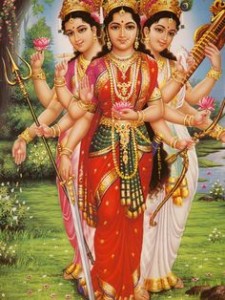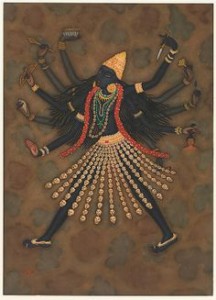
According to the Vedic calendar, immediately following Pitru Paksha comes a much more joyous celebration. Today marks the beginning of the month of Ashwina in Vedic astrology and the first of nine nights of the Indian holiday of Navratri 2014 (also spelled Navaratri). Navratri marks nine nights of celebrating the goddesses Kali, Lakshmi, and Saraswati.
Vedic astrology or Jyotish utilizes a lunar based calendar. Given the differing time global zones, Navratri 2014 commences on different days this year. Mypanchang.com lists the dates of Navratri for various countries. In North America and the West Indes, Navratri 2014 begins on September 24. It commences on September 25, 2014 in India and the rest of Asia, Europe, Africa, Australia and New Zealand.
I spoke to Vedamurti Shri Vivek Godbole, the head acharya at the Shri Krishna Yajur Veda Pathashala in Satara, Maharashtra, India. He is a 15th generation Brahmin. What follows is his discussion regarding about Navratri.
During Navratri, the first three nights are for Maha Kali, then the next three nights are for Maha Lakshmi, and then the last nights are for Maha Saraswati. In a more subtle sense, each group of three nights is dedicated to one of the goddesses. The first night is Kali, the second is Lakshmi, and the third is Saraswati. The fourth night is Lakshmi, the fifth is Kali, and the sixth and seventh are Saraswati. The eight is Lakshmi, and the ninth night is for Kail.
Maha Kali is an embodiment of strength. She gives you bala or shakti. Maha Kali assists all kinds of laborers who work in the fields and farms and who don’t require that much academic intelligence in their work. They don’t have a lot of money or education. But, they do know how to put forth effort. All the time, most people in this world have to exert a great deal of a of effort. For them, Kali provides them with a lot of strength. For these people, the source of their wealth lies in their strength.

(I mentioned to Vivekji about how in the West we often see images of Kali standing in the graveyard and with her tongue sticking out). Kali appears in her ugra or fierce form for people who are ignorant and cruel. Her fierce demeanor is shown only to selfish people who are only thinking of what they want. They will steal from others. Otherwise, Kali is Mother Earth. Ramakrishna Paramahamsa was a devotee of Kali and he was very humble. He did not see her furious form in her but envisioned her as his friend and the object of his worship. The way in which you perceive her is the form which she will display to you. People think they will kill an animal in front of her and then they will get happiness. Due to this ignorance, people kill animals and birds in front of Gods and Goddesses. This is adharmic and not according to the scriptures. We should kill the animal that displays itself as anger. We can also kill our lust and our ego. But people rarely think that way.
Maha Lakshmi comes to us in the form of gold, silver, and gems. All types of wealth are Lakshmi. Some people have the false notion that Lakshmi means just gold or currency. In this world, every person is thinking only about finances, but Lakshmi represents more than that. She also has the attributes of good health, righteousness and generosity. She is radiant and full of gratitude. The person who is healthy, wealthy, and generous is truly a rich person.
Maha Saraswati is pure knowledge. All kinds of knowledge and arts are related to Saraswati. This includes speech, writing, studying, playing music, poetry, and singing.
During the nine nights of Navratri 2014, we pray to these goddesses. Durga embodies all three goddesses. There is a particular goddess to be worshiped for each of the nine nights. That is covered in the next post.
The Shri Krishna Yajur Veda Pathashala in Satara, Maharashtra, India will be offering special pujas during Navratri 2014. The first puja is the chanting of the Chandi Path or the Durga Saptashloki. This is 700 stanzas dedicated to Durga. Sage Markandeya composed this. It takes 2.5 hours. The dakshina is $51. The second puja is Kumkum archan and chanting of Lalita Trishati (chanting 300 stanzas to the goddess Lalita). This entails offering kumkum (red sandalwood) powder to the Shri Yantra. The dakshina for this is $51. The third puja is chanting the Lalita Sahasranam (1000 stanzas to the goddess Lalita) and performing a Chandi Homa or Vedic fire ceremony dedicated to the goddesses. The dakshina for this is $101. To participate, please send an email to: sohamvg@gmail.com along with your full name and a photo of yourself. You will be provided with payment instructions.
Wishing you a very happy and joyous Navratri 2014!
Recent Comments
As a devi devotee, of course I love this! Thank you for the beautiful way you describe Kali’s grace. Thank you for a brilliant article. Happy Navratri. Jai Ma, Jai Durga!
Thank you Laura! Happy Navratri to you as well and many blessings!
Comments are closed.